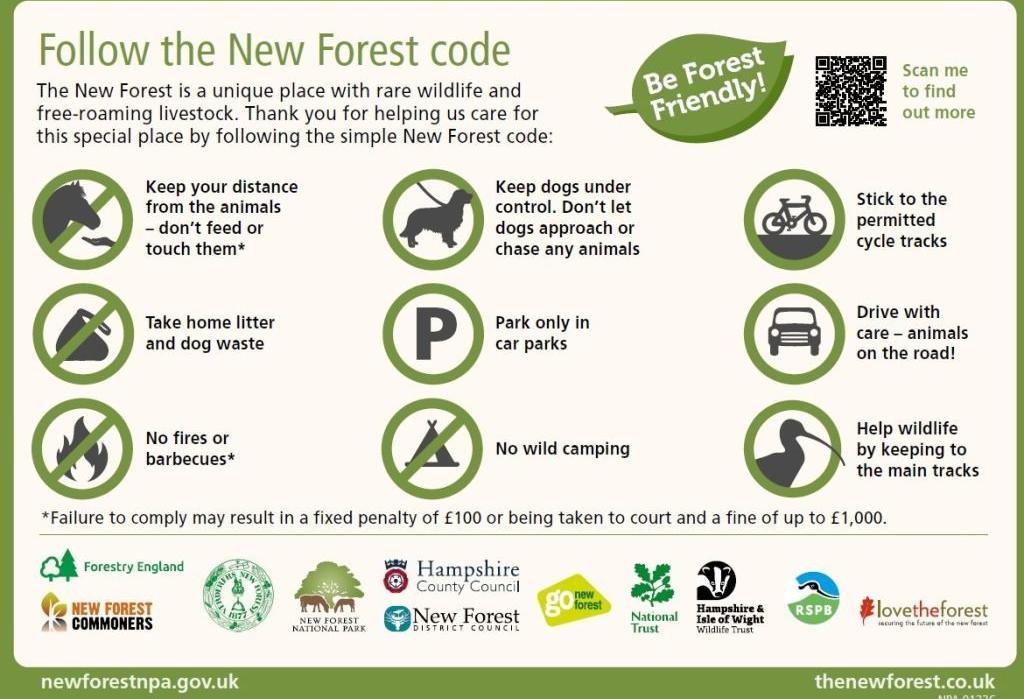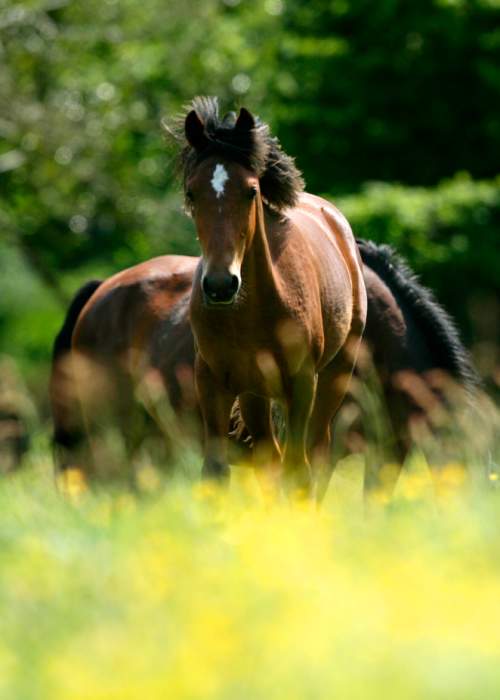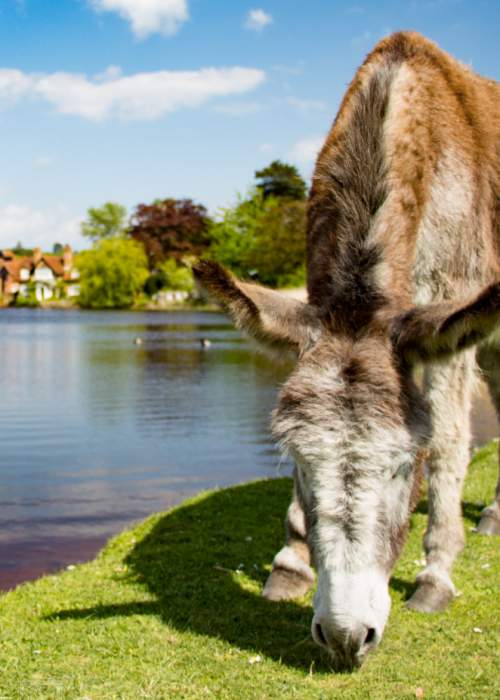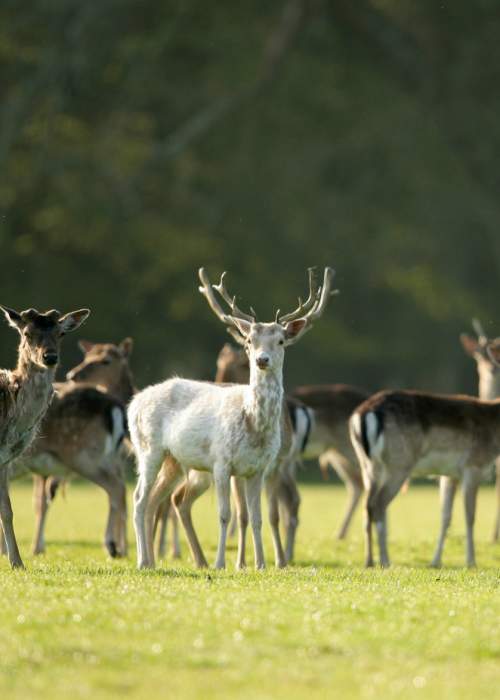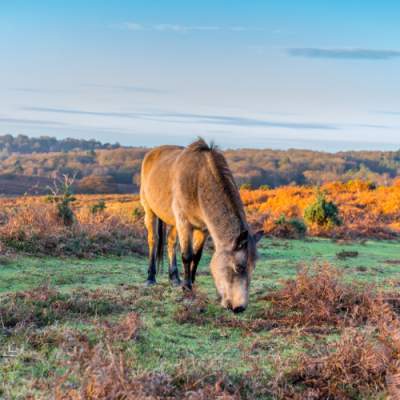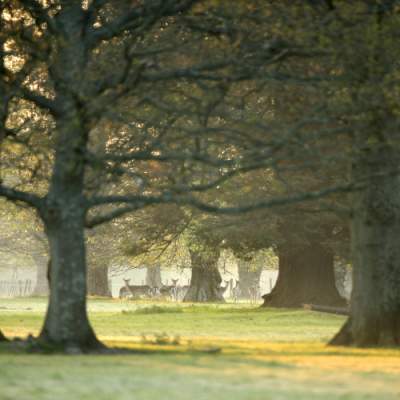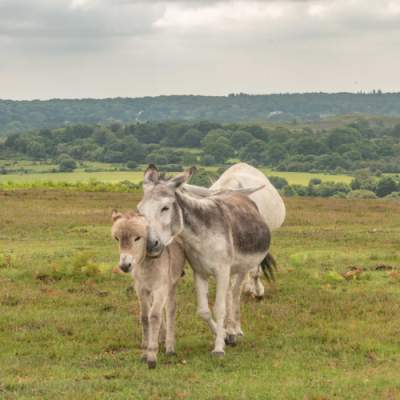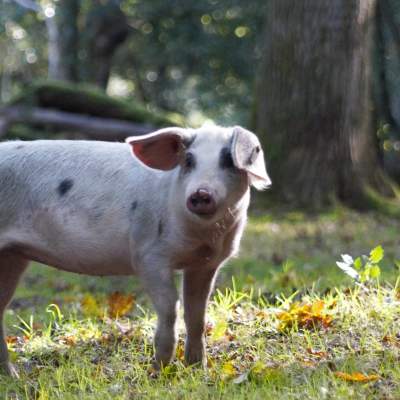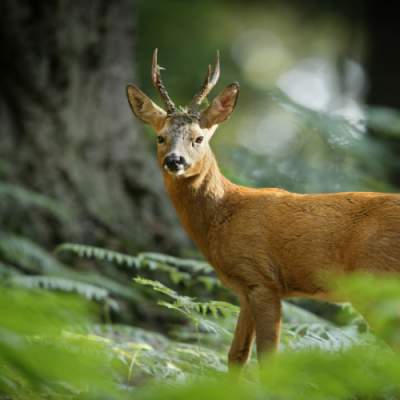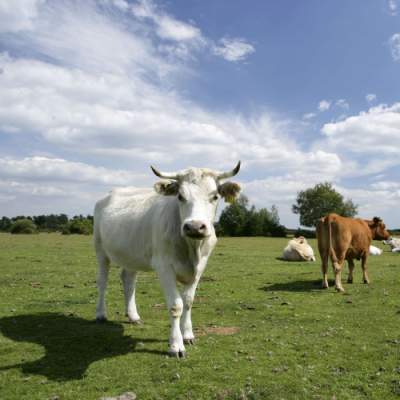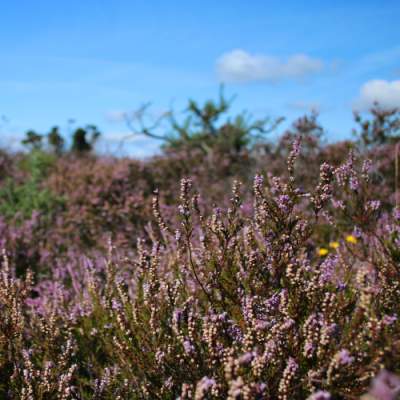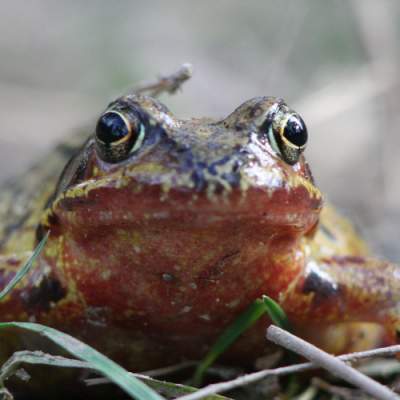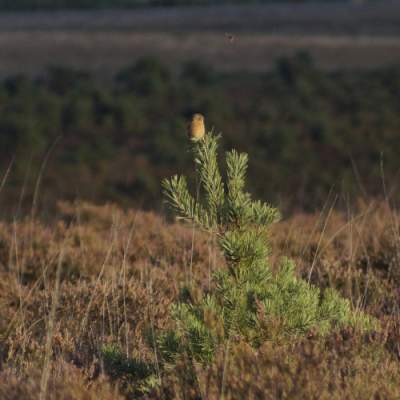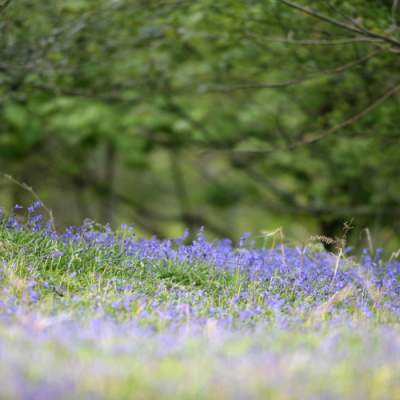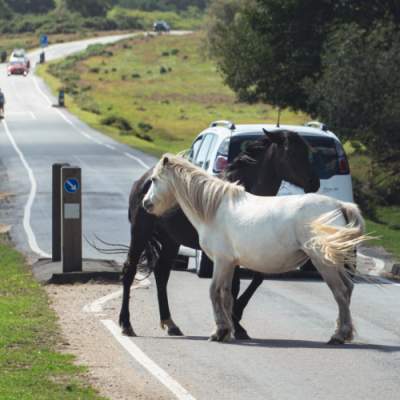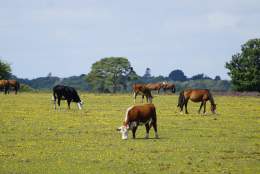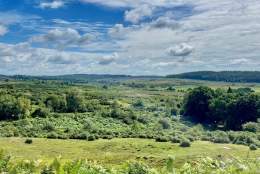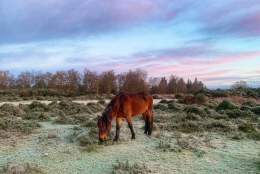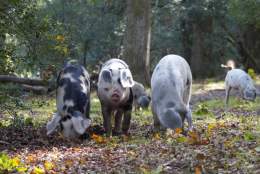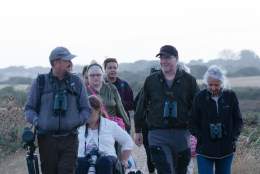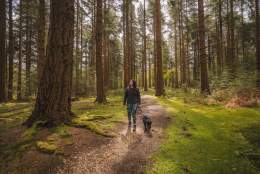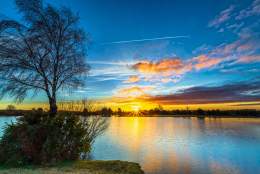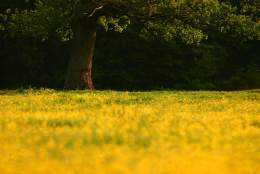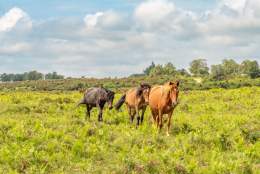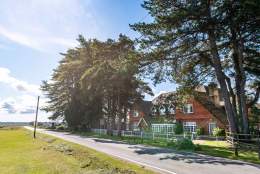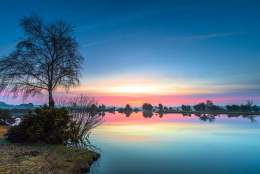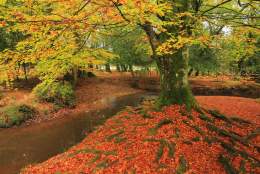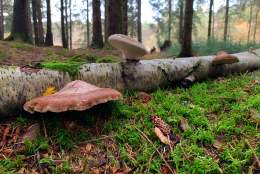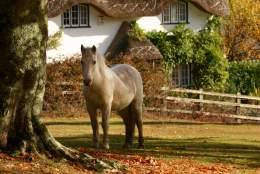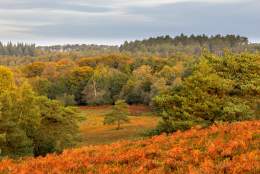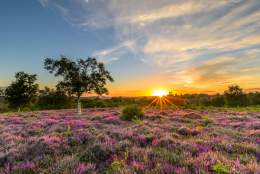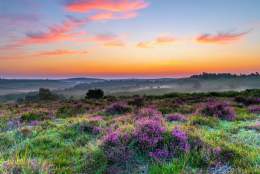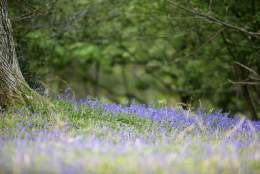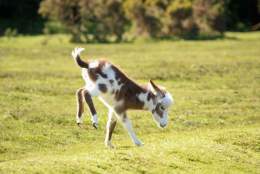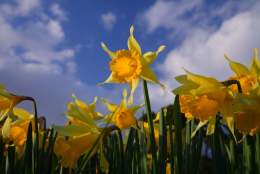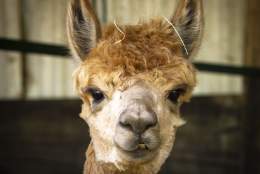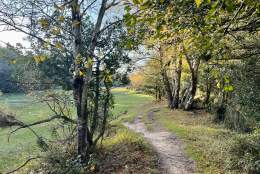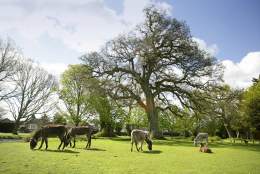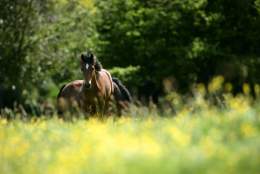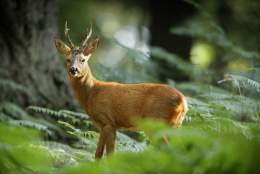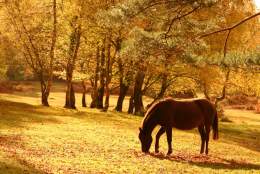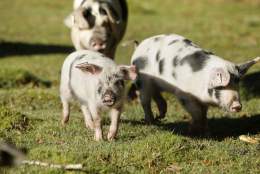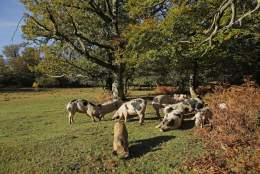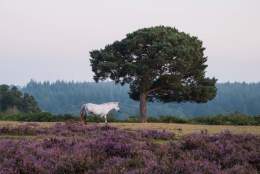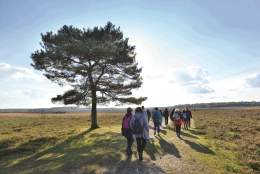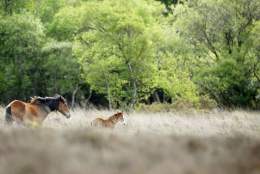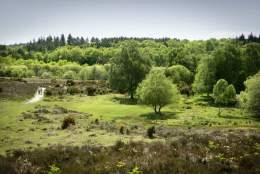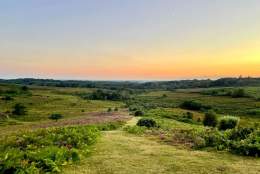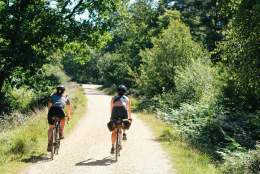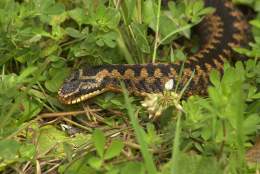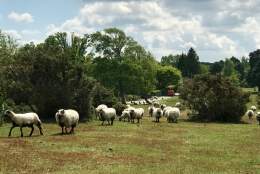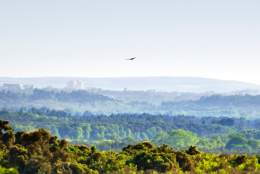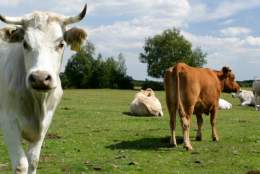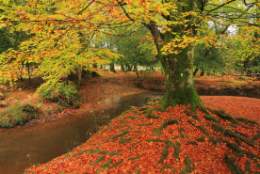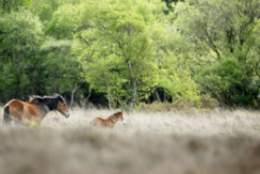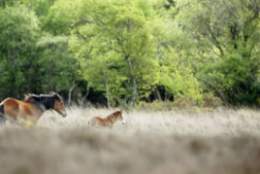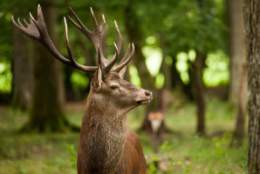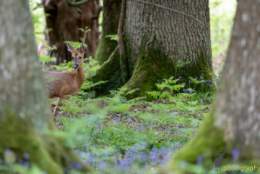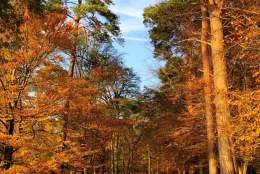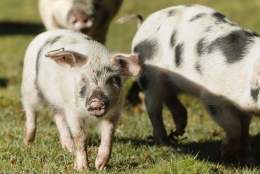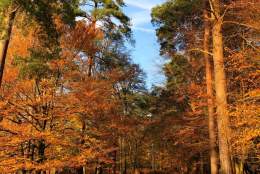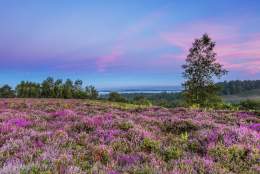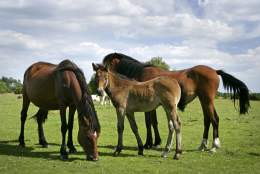New Forest Wildlife and Nature
The New Forest is one of the most special places for wildlife in the UK - a living, working landscape where people, animals and nature have shared space for generations. Wander through its ancient woodlands and open heathlands and you’ll find yourself among free-roaming ponies, grazing cattle, red deer and rare birds. Life here moves with the seasons, and every visit offers something new to discover.
From majestic oaks to the tiniest fungi, from the flash of a dragonfly to the call of a curlew, the New Forest is a place to slow down, look closely, and feel connected to the natural world around you.
Free-roaming animals in the New Forest
The most iconic residents of the New Forest are its free-roaming animals. Around 5,000 New Forest ponies wander freely through the landscape - a sight that makes this National Park so unique. Alongside them, you’ll often see donkeys, cattle and, in autumn, pigs, which are released for pannage to eat fallen acorns and nuts that are harmful to ponies.
These animals aren’t wild - they belong to local commoners who hold traditional grazing rights. But they are unsupervised, and they play a vital role in shaping and maintaining the New Forest’s patchwork of habitats.
Deer and other woodland wildlife in the New Forest
The New Forest is home to five species of wild deer: red, roe, fallow, sika and muntjac. You may catch a glimpse of one deep in the woods or peering over gorse on the open heath. For a higher chance of a sighting, head to Bolderwood Deer Sanctuary.
Find out more...
Reptiles and amphibians in the New Forest
The New Forest is one of the best places in the UK for reptiles and amphibians, with all six native reptiles living here. The warm, open heathland provides perfect basking spots for adders and grass snakes, while frogs, toads, newts and lizards thrive in the area’s wetlands and ponds.
To learn more about these secretive creatures, visit the New Forest Reptile Centre near Lyndhurst, where you can see native species in specially designed viewing enclosures. Open seasonally.
Birdlife in the New Forest
With its rich mix of heathland, wetland, woodland and coastline, the New Forest is a year-round haven for birds. Over 100 species breed here, including some of the UK’s rarest. In spring, listen for nightjars, woodlarks and Dartford warblers. In winter, look out for visiting birds like fieldfares, bramblings and ducks gathering in the area’s nature reserves and lakes.
Bring your binoculars - or just stop and listen. The New Forest’s birdsong is a joy in every season.
Flora, fauna and fungi in the New Forest
The New Forest’s ancient woodland bursts into life each spring, with carpets of bluebells, unfurling ferns and the first green leaves of mighty oak and beech trees. In summer, heathlands turn purple with flowering heather. Come autumn, the forest floor comes alive with mushrooms and fungi - over 2,700 species have been recorded here.
Each season has its own colour palette and rhythm. And each is a chance to see the New Forest’s plant life in full display.
Read more about our wildlife...
The Big 5 - Animals of the New Forest
- 4 minute read
Meet the five free-roaming animals that shape the New Forest - and what makes each one so special…
The New Forest’s top ten breathtaking viewpoints
- 3 minute read
The New Forest is full of places that stop you in your tracks. From wide, open heathlands to ancient…
How best to spend spring in the New Forest
- 4 minute read
Spring in the New Forest is nothing short of magical. As the landscape awakens with fresh greenery…
How best to spend winter in the New Forest
- 3 minute read
Winter in the New Forest unveils a gorgeous landscape, offering a unique charm distinct from the…
It’s Pannage time!
- 2 minute read
When is Pannage? Looking for something truly unique? This year Pannage takes place in the New Forest…
Guest blog: Wild New Forest
- 2 minute read
Who we are? Wild New Forest Guided Tours is a community interest company (CIC) dedicated to…
The best places to see the trees in the New Forest
- 2 minute read
The New Forest, filled with ancient woodlands, rolling heathlands and vast grasslands, is a…
Summer sunrises and sunsets
- 2 minute read
Experiencing the colourful magic of sunrises and sunsets is a wonderful moment, and there’s…
Discovering the spring and summer colours in the New Forest
- 4 minute read
Here in the magical New Forest, discovering the spring and summer colours is one of our favourite…
Tips on caring for the New Forest
- 4 minute read
The New Forest is a special place, full of natural beauty and is home to a diverse range of wildlife…
Best hotels with direct forest access
- 4 minute read
What are the New Forest’s best hotels with direct forest access? It’s a question that…
10 reasons to visit in the winter
- 2 minute read
Happy first day of winter! Come and experience the magic of the New Forest during this wonderful…
10 reasons to visit in the autumn
- 4 minute read
Happy first day of autumn! With the leaves turning extraordinary hues of orange and the mischievous…
Fungi Facts
- 1 minute read
With autumn comes the stunning array of magnificent fungi across the New Forest. From bright red…
Autumn wildlife
- 3 minute read
Cooler days and darker nights mean only one thing – autumn’s coming! But, as summer…
Book autumn breaks to the New Forest
- 4 minute read
If you’re suffering with the slight washout summer blues then cure them by planning a…
10 reasons to visit in the summer
- 3 minute read
Hip hip hooray – it’s the first day of summer today! Perhaps the happiest season of…
How to celebrate summer solstice in the New Forest
- 3 minute read
If you’ve always wanted to celebrate a summer solstice but couldn’t face the…
Vibrant Spring Colours in the New Forest
- 3 minute read
There are sound scientific reasons why looking at colour can enhance our feelings of wellbeing and…
10 reasons to visit in the spring
- 4 minute read
Happy first day of spring! The days start to get longer, the weather gets warmer and flowers begin…
Spring Scents
- 3 minute read
Nothing says spring more than its delightful and delicate scents - yet stopping to indulge our most…
Top Days Out for Animal Lovers in the New Forest
- 5 minute read
From the cute and furry to the scaly and fierce. Native to exotic, there are plenty of opportunities…
5 top reasons to get outdoors and boost your mental wellbeing
- 4 minute read
There’s a whole host of reasons why being outdoors benefits your mental wellbeing. Now, with…
Animal Fact Files : Donkeys
- 2 minute read
Our Animal Fact Files focus on one animal that you can find in the New Forest and each blog will…
23 Reasons to visit the New Forest in 2023
- 5 minute read
1. Our Ancient Woodlands. The New Forest has the highest concentration of ancient trees than…
Animal Fact Files : Deer
- 3 minute read
Our Animal Fact Files focus on one animal that you can find in the New Forest and each blog will…
Best places to see autumn colours
- 4 minute read
From the mightiest oaks to the most delicate of birches; from scarlet fungi to yellow-specked…
Animal Fact Files : Pigs
- 2 minute read
Our Animal Fact Files focus on one animal that you can find in the New Forest and each blog will…
It’s time for Pannage!
- 3 minute read
Everyone knows about the New Forest’s world-famous free-roaming ponies. But did you know we…
Animal Fact Files : Ponies
- 2 minute read
Our Animal Fact Files focus on one animal that you can find in the New Forest and each blog will…
Top reasons to go on a guided walk
- 4 minute read
Whether you are a new visitor to the New Forest or know it well, a guided walk can show you parts of…
Commoning and the working New Forest
- 4 minute read
One thing that you may not know about the New Forest is that all of the free-roaming ponies, cattle…
Connect with nature in the New Forest
- 4 minute read
Did you know that spending just two hours a week in the green or blue outdoors – or nature…
The New Forest’s Top 10 Beauty Spots
- 4 minute read
Here in the magical New Forest, our problem isn’t finding the top ten beauty spots…
Embrace the great outdoors
- 6 minute read
Here in the magical New Forest, we’ve been embracing the Great Outdoors for many years! Now…
Animal Fact Files : Reptiles
- 2 minute read
Our Animal Fact Files focus on one animal that you can find in the New Forest and each blog will…
Animal Fact Files : Sheep
- 1 minute read
Our Animal Fact Files will focus on one animal that you can find in the New Forest and each blog…
Spring Wildlife in the New Forest
- 5 minute read
The sun is out, the days are longer – and, after a long dark winter, the magical New Forest…
Animal Fact Files : Birds
- 2 minute read
Our Animal Fact Files will focus on one animal that you can find in the New Forest and each blog…
Animal Fact Files : Cattle
- 1 minute read
Our Animal Fact Files will focus on one animal that you can find in the New Forest and each blog…
Nature’s Fireworks are about to begin! Autumn Colours in the New Forest...
- 4 minute read
As the temperatures drop and the days shorten, something magical is happening in the New Forest. The…
New Forest Free Roaming Animals
- 5 minute read
If there’s one thing the New Forest is famous for beyond everything else, it’s our…
Be New Forest Friendly…
- 4 minute read
The New Forest is a unique and special place, rich in nature and wildlife, including our famous…
Top Wildlife Attractions in the New Forest
- 5 minute read
The magical New Forest is famous for its roaming ponies and donkeys. But what about our fallow deer?…
Top Spring Walks in the New Forest
- 6 minute read
The longest, darkest winter is over and spring is finally here! There’s no better way to make…
Autumn Colour Walks in the New Forest
- 4 minute read
They’ve been described as Nature’s Fireworks and when you see them you’ll…
Pannage Pigs in the New Forest 2020
- 2 minute read
*UPDATE : THIS YEAR'S PANNAGE SEASON HAS BEEN EXTENDED TO 21ST DECEMBER 2020. For 2020, pannage…
It's nearly time for a little Leaf Peeping – Autumn in the New Forest
- 3 minute read
Leaf Peeping is the lovely American term for the very agreeable pastime of travelling to photograph…
Top 5 Places to see the Heather in the New Forest
- 3 minute read
One of the best sights of the New Forest in the summer is the spectacular, vibrant heather sweeping…
How to be a Forest Friendly visitor - it’s really easy to do the right thing!
- 5 minute read
Now that lockdown is easing, you'll want to come and visit the magical New Forest. And our…
How to explore and learn more
One of the best ways to discover the New Forest’s wildlife is to join a guided walk or cycle tour. Companies like Wild New Forest Guided Tours and The New Forest Off Road Club offer expert-led experiences that bring the New Forest’s flora, fauna, and conservation work to life.
You can also learn more at the New Forest Heritage Centre in Lyndhurst - a free-to-enter museum and information hub - or visit the Blashford Lakes Nature Reserve near Ringwood, managed by the Hampshire & Isle of Wight Wildlife Trust, for birdwatching and nature walks.
Bolderwood, managed by Forestry England, is another great starting point. From the car park, waymarked trails and information panels guide you through forest landscapes full of stories and seasonal interest.
Protecting the New Forest and its wildlife
The New Forest has been a National Park since 2005. This special designation protects it for future generations, and with that comes a shared responsibility for us all.
Nearly half of the New Forest is managed by Forestry England, while commoners continue centuries-old traditions of grazing their animals on the open land. With so many species calling this place home - from free-roaming ponies to rare insects and birds - it’s vital that visitors help care for the land.
Here’s how you can help:
-
Follow the New Forest Code: Stay on the path, keep dogs close, and take litter home.
-
Never feed the animals: Human food can harm ponies, donkeys and cattle.
-
Leave fungi and plants where they are: Many are rare or protected, and foraging without permission is not allowed.
-
Drive carefully, especially at night - animals often cross roads unexpectedly.
A place to connect, not collect
The New Forest is more than a place to visit - it’s a living landscape that invites connection. Every bird call, hoofprint and fallen leaf tells part of the story. With care, curiosity and respect, we can each become part of that story too.
